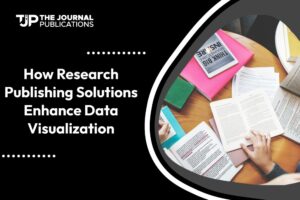Intro
Indexing in renowned databases such as PubMed, Scopus, and Web of Science has lately become one surefire way for journals to expand their reach, credibility, and impact in academic and professional circles. Proper indexing of a journal increases its visibility and attracts higher citation rates which greatly motivates authors in choosing where to publish their papers.
Here we have outlined some central indexing strategies and how they contribute to effective journal publication service, including the benefits of indexing and abstracting services in leading scholarly databases and the requirements.
Intro to Indexing in Journal Publication Services
Indexing refers to the process of listing the journal in an established database or directory commonly used by researchers and academics in their efforts to find appropriate works. Major indexes receiving a journal enhance the chances of being found by a big group of researchers, academicians, and policy-makers. An academic journal is concerned with results-oriented indexing strategies at its core publishing and promotion efforts, helping it increase its reach and reinforcing its academic standing.
Why Indexing Matters to Academic Journals
Indexing is a core strategy for journals that want to achieve authority and broaden their readership. Generally, indexed journals receive more citations because they are easily found through the most commonly used academic databases. Researchers want to publish more in indexed journals because of the better visibility and prestige associated with extremely well-indexed journals.
Top Databases for Journal Indexing
Most journals consider being listed in databases to be of high priority, taken to be highly profiled.
Some of the leading indexing services include:
- PubMed: Primarily life sciences and biomedical research.
- Scopus: It’s a multidisciplinary database that epitomizes global journal coverage, books, and conference papers.
- Web of Science: Highly selective, citation-based index.
- DOAJ: Directory of Open Access Journals – is a directory that supports open-access journals with a focus on quality and transparency.
Since each database has its selection criteria and indexes certain academic disciplines, it’s becoming increasingly important for a journal editor which indexes best correspond with the scope of their journal.
Types of Indexing Services for Journals
Indexing services vary, from subject-specific and multi-discipline open-access to purely commercial. Understanding the categories of indexing services empowers journals to make appropriate indexing strategy choices for ultimate reach to their audience and publishing goals.
Subject-Specific Indexes: Oriented to specific subject areas, such as PsycINFO for psychology.
Multidisciplinary Indexes: Have a large subject area of interest, like Scopus and Web of Science.
Free open-access indexes: These include indexes like DOAJ, which indexes only open-access journals.
Indexes by Region and Language: Help journals reach out in their target audience of non-English speaking or regional audience.
Steps to Get Your Journal Indexed in Major Databases
Journals have to undergo some sort of evaluation process to be indexed. Here’s a generalized quasi-approach:
- Quality Check: Ensuring that the editorial standards maintain the requirements set out by the database.
- Application Submission: Each index has a lot of hassle in the application process.
- Documentation of Peer Review Process: Evidence of a rigorous and transparent process of peer reviews.
- Regular Publication Schedule: Showing regular publication history.
Quality Thresholds Used by Best-in-Class Performers
Top indexes demand from journals the following standards:
Quality of Academics: The scholarly quality of the editorial board includes the quality of the articles published.
Transparency in Peer Review: Approximate indexes, such as Web of Science and Scopus, rate journals on how much transparency they have and the process of Peer Reviews.
Ethical Publication: The journal follows the standards laid down by the Committee on Publication Ethics (COPE).
How Indexing Improves Journal Visibility
Indexing a journal increases its visibility to a wider audience through established academic databases. Thus, an indexed journal becomes more visible to those researchers, students, and academics using such databases, resulting in higher engagement with its constituent articles.
Impact of Indexing on Journal Citations
Being indexed encompasses a respected listing that leads directly to increased citations for a journal. While literature review or even conducting citations, researchers are likely to favor articles appearing in indexed journals since these are perceived as credible, preferably authoritative sources.
Challenges in Journal Indexing
While indexing is beneficial, journals then risk suffering from several challenges:
- Meet Criteria for Index Inclusion: Not all journals meet the criteria for top indexes, and the strict requirements are sometimes hard to keep.
- Standards Maintenance: Maintenance of standards for quality in peer reviewing and publication ethics is an ongoing process.
- Resource-Intensive Process: The application and maintenance of indexed status is at times very labor-intensive and expensive.
Abstracting is Key to Improved Discoverability
Abstracting services have to do with indexing in order to improve the visibility and reach of the journals. The journals increase their reach by providing well-penned summaries with the use of abstracting databases, therefore attracting readers and researchers to consider the full text.
Indexed Journals: Indicators
The common metrics available to measure the impact of indexed journals are:
- Impact Factor: The average number of citations in recent articles is the measure of this metric.
- Index h: It gives the productivity along with the citation impact.
- The Cite Score, provided by Scopus gives an impression of the citation performance of a journal.
Those metrics are useful indicators of the diffusion and influence of a journal and, as such the guidance to authors on where to publish, and to readers where to find high-impact research.
Abstract Development to Ensure Indexing Success
The better the abstract, the greater the likelihood that, in turn, the journal gets selected for indexing. Abstracts must be accurate, point out important results, and contain relevant keywords in reasonable numbers with a view to ensure visibility in abstracting services and search engines.
Best Practices for Maintaining Indexed Status
Maintaining indexed status requires a commitment to ongoing quality and consistency. Here are some best practices:
- Publish at regular intervals: this enable meeting deadlines to retain the publication credential.
- Review of Editorial Standards: Contribute to developing standards of continuous quality.
- Regularly update peer-review procedures: Ensuring peer-review processes are transparent and robust.
Case Study: How Indexing Affects Journal Success
These are well-documented effects of indexing in the literature, where such journals are rewarded by high increases in article citations and overall impact. Many journals have stated that improvements in the reach of articles and submission rates attract leading authors and broaden readership after successfully working through the indexing process.
Close: The Future of Indexing and Journal Paper Publication Service
Indexing continues to feature among the journal publication service strategies as academic standards evolve and dissemination becomes increasingly competitive. After all, it is again best practices and hopes for inclusions of index that keeps the journals relevant and successful in the academic community.
FAQ’s
-
Why is indexing important as far as the visibility of the journal is concerned?
Indexing in various databases such as Scopus and PubMed increases the visibility of articles to researchers, thereby increasing their citation rates, which in turn enhances the reputation of the journals.
-
What are the major criteria for a journal to be indexed?
Major indexes require quality standards, a transparent peer-review process, adherence to ethical guidelines, and regular publication.
-
How does abstracting vary from indexing?
Abstracting indexes list high-quality journals in databases with a summary of the content so that you discover easily and read more of the core content.
-
Can each type of journal be indexed?
Not all journals qualify; their indexes usually select journals based on strict criteria, targeting those with established editorial and publishing quality.
-
What is the impact of being indexed on journal citations?
Journals that have been indexed are more likely to be cited. Researchers show a preference for publications that are better recognized and credible, this gives an increased reach of articles.
-
Are open-access journals indexable?
Of course, open-access journals are listed in the directories, such as DOAJ, which supports quality, accessible research.





